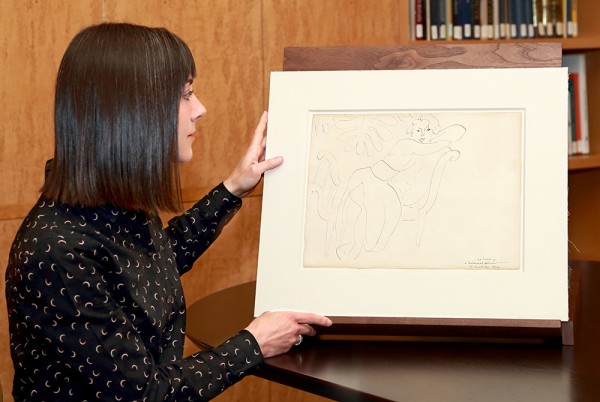Matisse’s Homage to Catherine Viviano

Photo by Ramona Trent
The Norton Simon Museum is delighted to announce the acquisition of an ink drawing by Henri Matisse, generously bequeathed by the estate of Carol Moss Spivak. This charming, informal study depicts a woman in exotic costume, loosely identified as an odalisque, as she lounges on a carved wooden settee. Overhead, the fronds of a split-leaf philodendron—Matisse’s favored houseplant—reach toward the undulating forms of the furniture and its languid occupant.
The untitled drawing dates to 1936, at a time when Matisse was living in Nice and working closely with Lydia Delectorskaya, his model and trusted studio assistant. Delectorskaya was a Russian émigré to France who began working for Matisse in 1932 and remained with the artist until his death in 1954. As both muse and manager of the artist’s affairs, she was instrumental to Matisse’s productivity during his late years, and she became well known for the pose she adopts here: her head resting on crossed arms as she leans against a table, bed or the back of a chair. Matisse was fascinated by the candor of this position, as well as the decorative, arabesque-like shape that it creates from the model’s prostrate body. He produced dozens of representations of Delectorskaya over the next four years, depicting her for no less than three hours nearly every single day.
This particular study of Delectorskaya intrigued curators at the Museum because it bears an inscription in the lower right corner: “En hommage à Mademoiselle Catherine Viviano, H. Matisse 1947” (In homage to Miss Catherine Viviano, H. Matisse 1947). Viviano was an Italian-born art dealer who for many years worked at the Pierre Matisse Gallery in New York, owned and operated by Henri Matisse’s son. She received this drawing as a gift after announcing her intent to leave Pierre Matisse’s employment to start a gallery of her own. As Viviano recalled, Henri Matisse sent her a letter in which he asked her to kindly reconsider her plans, declaring that his son simply couldn’t manage the gallery without her. Perhaps to underscore this point, Matisse selected a drawing for Viviano that depicts his own treasured assistant, offering a fascinating point of connection between two women, living and working an ocean apart, each of whom was considered essential to the Matisses’ professional success.
Matisse’s present did not, in the end, persuade Viviano to give up her dream to open her own art dealership. She ran the Catherine Viviano Gallery in New York between 1949 and 1970, representing a number of postwar Italian artists as well as the estate of German painter Max Beckmann. However, Viviano clearly recognized the importance of Matisse’s gesture, and she kept this drawing for the rest of her life. After her death in 1992, it passed through the hands of several dealers in New York and Toronto before entering the collection of Carol Moss Spivak, a noted philanthropist in Southern California. To honor Mrs. Spivak’s bequest, and the succession of female collectors, art dealers and assistants that it represents, the Museum will display Untitled (En Hommage à Catherine Viviano) in October alongside related paintings by Matisse in the Norton Simon collections. As the first drawing by Matisse to enter the Museum’s holdings, it joins three paintings, 80 prints and two autograph letters by this artist, and it will greatly enrich the stories that can be told about Matisse and the women who worked with him.
—Emily Talbot, Assistant Curator
This article first appeared in the Museum’s Summer 2018 Newsletter.
